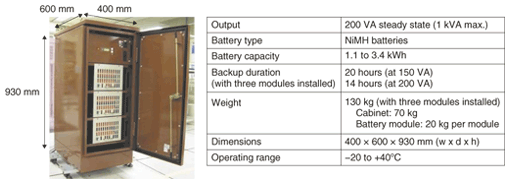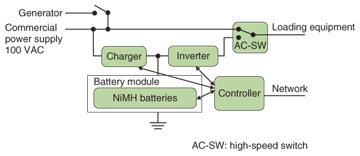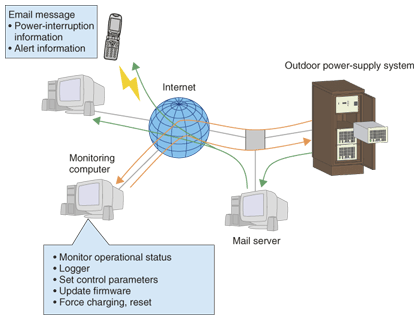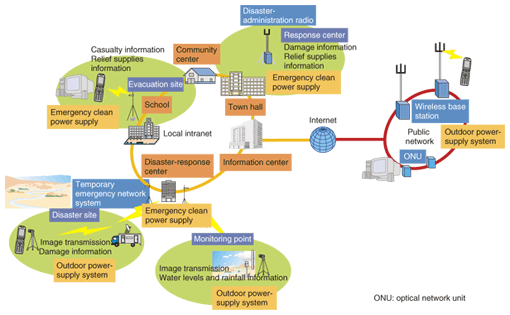 |
|||||||||||||||||
|
|
|||||||||||||||||
|
Special Feature: NTT Technologies for the Environment and a Safe and Secure Society Vol. 6, No. 2, pp. 11–16, Feb. 2008. https://doi.org/10.53829/ntr200802sf2 Outdoor Power-supply SystemAbstractThe outdoor power-supply system described in this article can provide mission-critical outdoor equipment with stable power for prolonged periods of time. This will enable monitoring systems and emergency radio systems that gather and communicate information during disasters to continue to operate during power outages.
1. Introduction1.1 Rising awareness of need for emergency preparednessIn 2007, Japan experienced several large-scale natural disasters. These included two typhoons, #5 and 9, which caused extensive rain and storm damage, and two major earthquakes: the Noto Peninsula earthquake in March and the Niigata Chuetsu Offshore Oki earthquake in July. To guard against such natural calamities, ordinary businesses and the private sector as well as government agencies have, in the last few years, been pressing ahead to establish systems and facilities that take into account risk-management strategies and disaster-response measures [1]. NTT is also working on a number of measures to cope with emergencies based on the basic principles of improving the reliability of the communications network, securing essential communications, and ensuring fast recovery of services. Among the services that NTT Group companies operate, a number of outdoor systems—such as river monitoring systems, road monitoring systems [2], and radio systems for disaster response and administration [3]—are used to coordinate safe evacuation and relief operations for residents during emergencies. Additionally, in the wake of the 2004 Niigata Prefecture Chuetsu earthquake, government bodies have led the ongoing construction of systems that monitor the operation and maintenance of rivers, roads, harbors, and other infrastructure on a nationwide level [4]. 1.2 Requirements for outdoor power suppliesIn normal circumstances, outdoor disaster-response systems are powered by commercial power sources. This arrangement, however, is vulnerable during disasters because power interruptions can knock out the systems' vital initial-response capability. Thus, emergency power supplies are essential components of disaster-response systems deployed outdoors. The three main requirements that these emergency outdoor power supplies must meet are to: (1) supply power for extended periods, (2) withstand harsh conditions and function dependably, and (3) be packaged in a light and compact form factor [5]. Present-day emergency outdoor power supplies run on lead-acid batteries. The drawback with these supplies is their limited backup times of only several hours. If power outages persist longer than this, portable generators must be transported to the site to keep equipment operating. In cases where there is extensive damage, it may be impossible to reach the site or the site environment may be too dangerous to work in. For this reason, compact lightweight power supplies capable of longer backup times are in demand. 1.3 Development of backup power supplies by NTTNTT's communication centers and wireless base stations are equipped with backup power supplies to maintain communication services even in the event of a power failure. These power supplies make use of lead-acid batteries. But with the increase in the diversity and speed of provided services in recent years, today's communication devices tend to consume more power, which requires storage batteries with higher energy densities than lead-acid batteries to provide the same backup times. To address this need, NTT Energy and Environment Systems Laboratories targeted nickel-metal-hydride (NiMH) batteries, which have about three times the energy density of lead-acid batteries and are extremely safe, and developed a large-scale NiMH battery for backup applications. The battery that NTT came up with can be charged and discharged at temperatures as high as 55ºC, so it can function outdoors without significant deterioration even in severe midsummer heat. DC power-supply systems outfitted with these new batteries have already been installed as backup supplies at some wireless base stations [6]. Indoor power-supply systems powered by NiMH batteries are being deployed as temporary or emergency supplies that operate during disasters [7]. Uninterruptible power-supply (UPS) units, which use conventional lead-acid batteries, are capable of supplying power for only 10 to 15 minutes—just long enough just to perform a controlled equipment shutdown. On the other hand, a power-supply system running on NiMH batteries, with the same weight and dimensions, can provide backup power to equipment for much longer periods. These systems are beginning to be deployed as power-supply components in disaster-response systems. Recognizing the rising awareness of the need for emergency preparedness mentioned earlier and the clear urgent need for power-supply components for disaster-response systems in outdoor facilities, we developed a new outdoor power-supply system. 2. Outdoor power-supply system2.1 OverviewThe cabinet housing the outdoor power-supply system that we developed is shown in Fig. 1. The system shown here is a 3.4-kWh power-supply system running on NiMH batteries, which can provide about 30 hours of backup power at an output of 100 VAC/100 W. The cabinet has three racks for battery modules. Modules can be added or removed to tailor the backup capacity to suit the load. The total weight is 130 kg (with three modules installed); the storage batteries account for 60 kg of this weight. The structure of the outdoor power-supply system is shown in Fig. 2. In addition to the NiMH batteries, the system consists of a charger, an inverter, a high-speed switch, and a controller. Under normal conditions, the system powers the load from the commercial power supply. When a power outage occurs, the high-speed switch operates and the system continues to supply power to the load from the NiMH batteries via the inverter. As long as the commercial power supply is available, and especially when it has been restored after an outage, the system automatically charges the batteries to maintain them at or near full capacity ready for use. An input connector is provided for a portable generator separate from the commercial power supply. Thus, when a power outage continues for a significant time, an engine-powered generator can be hooked up to the system. The status of the outdoor power-supply system can be monitored remotely over the Internet, as shown in Fig. 3. The system can be programmed to send alerts about power outages/failures or low battery capacity to a preset email address.
2.2 Installation technology for NiMH batteriesBattery modules were developed as the basic component of the system to make it easier to handle the batteries. A module connects in series of ten cylindrical NiMH battery cells, each with current capacity of 95 Ah (Fig. 4). Every module has a built-in cooling fan for independent temperature control. Electrical connections are provided at the rear of the module case, allowing modules to be hot-swapped: no wiring is required. This greatly simplifies battery replacement and makes it safer and more efficient. Each battery unit weighs about 20 kg; light enough to be unplugged and carried. The backup time of the system can be extended by replacing a discharged module with an extra fully charged module.
2.3 Construction design technology for improved protection from the elementsOutdoor power-supply systems must be designed and constructed with a view to protecting the system from rainwater, accumulated snow, and toxic gases from volcanic activity. The power-supply cabinet, except for a small drainage hole in the bottom, is an airtight box and constructed to prevent the infiltration of rainwater or other substances. Unfortunately, this airtight construction causes the internal temperature to rise considerably during midsummer heat waves. A reliable passive thermal design is the primary method of controlling heat buildup inside the cabinet. The exterior of the cabinet is coated with infrared reflective material that reflects sunlight and radiant heat from the surroundings. The canopy, which receives the greatest amount of sunlight, has a double-layer sunlight-blocking shield. Inside, the inverter is particularly susceptible to increases in temperature. Therefore, we increased the thermal conductance between the inverter and its mount to promote thermal diffusion away from the inverter. Each battery module is cooled by a built-in fan that switches on when the battery temperature exceeds 45ºC. This cooling arrangement, in addition to the batteries' large thermal heat capacity, has been demonstrated to keep battery temperatures under their upper limit (55ºC during charging or discharging) even in midsummer heat. To protect against lightning strikes, the cabinet's inputs and outputs have surge-protection circuits (surge absorbers), which prevent damage to the internal circuitry. 2.4 Overcharge and over-discharge protection technologyNiMH batteries are considered to be very safe because they use an aqueous electrolyte solution. Nevertheless, they must be protected from overcharging, which leads to overheating and an increase in internal pressure. On the outdoor power-supply system side, the controller will stop charging if it detects a full charge or an abnormal temperature. A second safety mechanism using a separate temperature sensor inside the battery module will directly stop the charger if overheating is detected. Storage batteries have a limited operating voltage range. Continuing to discharge a battery while below its minimum operating voltage (over-discharging) will damage the battery and degrade its power storage capacity. To prevent over-discharging, the outdoor power-supply system has a full-shutdown mechanism that takes effect when the NiMH battery voltage drops below a set value. When the commercial power supply recovers after a full-shutdown, the system automatically reactivates and starts charging the batteries. This feature makes it unnecessary to restart systems in the field. 2.5 Technology for automatic detection of battery deteriorationStorage batteries deteriorate over time and with the number of charge-discharge cycles. Our outdoor power-supply system, however, is equipped with a function that automatically monitors the service life and state of deterioration of its batteries. This eliminates the need for the user to test the storage battery capacity and reduces maintenance because the user is notified by the system's monitoring function if battery deterioration is detected. 3. Comparison with competing productsOur outdoor power-supply system is compared with competing products in Table 1. Our competitors require two or three lead-acid-battery systems to deliver 20 hours of backup power at 150 VA, which represents more weight and installation area, not to mention a higher cost. Engine-powered generators are another alternative for outdoor power supplies capable of extended operation. Such generators, however, have several disadvantages: they emit harmful exhaust and are noisy when operating, require regular maintenance costs for refueling every six months, and are heavy and take up considerable space.
4. ApplicationsThe outdoor power-supply system that we developed is expected to see use as a power supply in disaster-response systems, as indicated in Fig. 5, by virtue of its durability, which allows it to be used in exposed areas even in midsummer, its ability to deliver prolonged backup power from a compact form factor, and its maintenance-free characteristics. Applications in disaster-response systems, which convey information from disaster sites and monitoring points via information networks, include emergency clean power supplies [7] as standby supplies in government buildings and schools and outdoor power-supply systems at disaster sites, monitoring points, and wireless base stations. When deployed in this fashion, our system can eliminate power-outage worries even in times of emergencies to ensure safe and secure operation of vital infrastructure.
5. Future developmentWe are now engaged in the research and development of technologies for large-capacity power-supply systems with the aim of replacing the lead-acid batteries now used as backup batteries in communication buildings and data centers. References
|
|||||||||||||||||


















